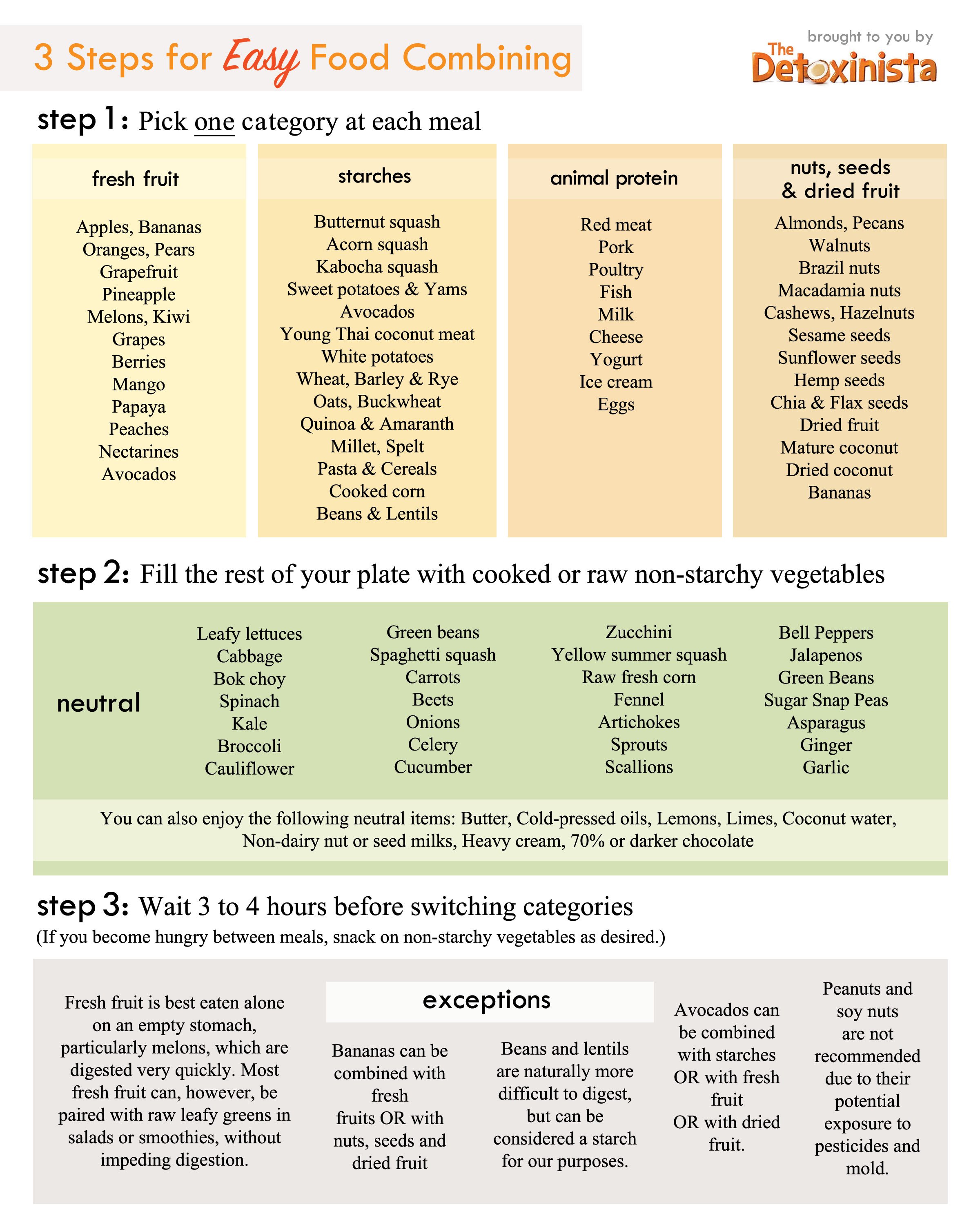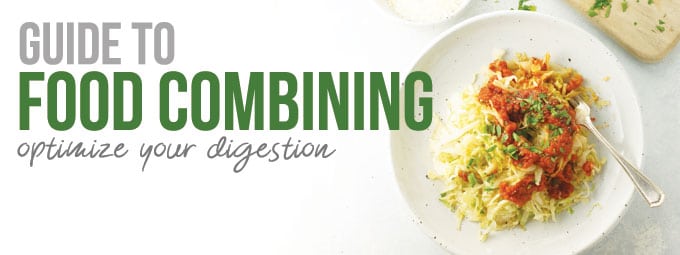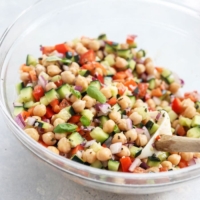Did you know that digesting food requires more energy than any other function in the human body? It’s no wonder we’re exhausted after a big lunch! It stands to reason, then, that the best way to free up some extra energy is to make our digestion as quick and efficient as possible.
Food combining is one of my favorite tricks to streamline the digestive process. Though food combining principles can get very complicated, depending on which expert you ask, I prefer to keep them simple. Simply pick just one dense food at each meal, whatever you’re craving most at that moment, and then fill the rest of your plate with raw and cooked non-starchy vegetables. Easy! By simplifying your meals, the digestive system doesn’t have to tackle too much in one sitting, helping you to avoid that bloated, sluggish feeling that can put a damper on the rest of your day.
Studies have shown that humans have a tendency to overeat when we are offered a wide variety of foods during a meal. (source) So, by simplifying our meals, we will naturally eat less, without counting calories or worrying about portion sizes.
Best of all, you don’t have to give up any food groups that you love– you just may not want to eat them all at the same time. The following guide should help!

As you can see in the chart above, the foods have been divided into four general categories:
- FRESH FRUIT
- STARCH
- ANIMAL PROTEIN
- NUTS/SEEDS/DRIED FRUIT
Note: Look for these food combining labels clearly marked in my cookbooks, and here on the blog. All of the recipes in my cookbooks are properly combined, and both cookbooks include properly combined meal plans to help you easily get started.
For a properly combined meal, simply choose ONE category and only eat foods out of that category for that particular meal. The foods listed within the same category combine well with each other, and you may also include anything from the “Neutral” column to fill out your plate.
Wait 3-4 hours between each meal, before switching categories.
—
Properly Combined Sample Meal Ideas
A properly-combined STARCH meal might look something like this:
A sandwich on whole-grain bread, filled with avocado, mustard, lettuce, tomato and sprouts. Served with a leafy side salad and a baked sweet potato topped with butter. You could follow this meal with some dark chocolate for dessert!
A properly-combined ANIMAL PROTEIN meal might look something like this:
A leafy green salad topped with cherry tomatoes and goat cheese, followed by a piece of baked fish served with a side of roasted broccoli and cauliflower. You could follow this meal with some dark chocolate or goat’s milk ice cream for dessert!
A properly-combined NUT/SEED/DRIED FRUIT meal might look something like this:
A leafy green salad topped with dried cranberries and raw walnuts, followed by a platter of raw hummus served with raw crudités. Dessert could be a slice of raw cheesecake, a few raw macaroons, or a couple raw almond butter cups!
FRESH FRUIT is best eaten in the mornings, on an empty stomach.
This is because fruit digests so quickly, typically within 30 minutes of eating. (However, fruit can be combined with leafy green vegetables in a green smoothie, if you like!) Fruit is not recommended as a dessert after a meal, as it could potentially cause fermentation, gas and bloating, and promote bacterial overgrowth in the body. You can eat fruit as an afternoon snack or post-workout, as long as it’s been 3-4 hours since your last properly-combined meal.
—
Note: There is a lot of debate over the science behind food combining, without much evidence to back it up. (There is little money to be made in this field, which probably accounts for the lack of funded studies.) Personally, I think why food combining works for me, and for many others, is that it encourages you to make better choices, without feeling restricted. When you’re choosing just ONE food category at a time, then filling the rest of your plate with raw and cooked vegetables, you’re bound to be making healthier choices! So, food combining may just work because it encourages the consumption of more whole foods and simpler meals.
I think it’s also important to note that there’s no need to be “perfect” with food combining rules all the time. I like to follow the 80/20 rule, because life’s too short to stress about what you’re eating.
For properly combined meal plans and entertaining menus, be sure to pick up a copy of my first cookbook, Everyday Detox.
My second cookbook, No Excuses Detox, has 3 more meal plans, including a Budget-Friendly properly combined meal plan that feeds you for less than $6 each day, and a Speedy Meal plan that has everything ready in 30 minutes or less. Both of my cookbooks are loaded with properly combined recipes to help make things easier for you.



Hi Mega, I wanted to know on what category would put tomatoes. I thought tomatoes were fruits and tht they could not be pares with staches. I saw your spelt pasta recipe that has marinera sauce and was confused becasue the sauce has tomato which is technically a fruit.
Thanks, Diana.
Non-sweet fruits, like tomatoes and zucchini, can fall into the neutral category with other raw vegetables.
Hi,
I’m allergic to almonds, coconut, peanuts, and much more. I was wondering if you have any suggestions for flours I can use that serve the purpose of food combining. I love to bake, but I want to make it better for digestion. Also, what category would you put quinoa in?
Any type of flour can work with food combining, if you pair it correctly. Traditional grain flours would work best in vegan baking, since they don’t combine with eggs or flax. I consider cooked quinoa to combine as a grain, but it may also fall into the nut/seed category for some, since it’s technically a seed/pseudograin.
Hi, many smoothies have veggies and fruits with some kind of nut added for fat. I was wondering, isn’t that a bad combination since nuts and seeds are in one category and fruits in another ( I know that veggies are neutral so they would not be a problem).
Thanks, Diana.
What catagory does a glass of red or white wine fit in?
Since wine is a liquid, it does not involve much digestion and can be enjoyed in moderation with almost any meal.
Is Minestrone okay to eat due to having pasta, beans and vegetables?
I typically combine beans as a starch, so in that case, the Minestrone would be fine.
if you cook the fruit, then can I combine it with other items? thank you.
Cooking the fruit will slow down its digestion, so in that case I will occasionally combine it with nuts and seeds (like in a grain-free peach cobbler) and it doesn’t seem to cause too much of an issue.
Does peanut butter and other nut butters fall into the nut/seed category?
Yes, nut butters do fall into the nut/seed/dried fruit category. Peanuts are not a nut, they are technically a legume, so they fall into a “gray area” with food combining and are best consumed with simple meals (like a raw salad) for best digestion. Many food combiners avoid peanuts in general to avoid potential aflatoxin exposure, but I consider them fine as a treat if you stick to the organic variety.
Dried fruits (sugar) and nuts (fat/protein) is the worst possible combination you can make, this is the only website that says the opposite.. and out of experience i know it’s a bad combination..
Ofcourse tastewise it’s great combination, but that’s not what this is about.. it’s about digestion.
In India people have yoghurt with Rice and vegetables with necessary spices regularly and maintaining good health please advise the Health benefits.
How about a meal with plant protein and starch? I didn’t notice too much of a problem with a small sweet potato with tofu and salad.
Hi Megan:
This website is beautifully done. I appreciate all of the information, recipes, and creativity you generously share. I was wondering if you would please tell me how soon after a meal do you wait until you eat dark chocolate?
I find your food combining information a breath of fresh air; there is a daunting amount of confusing charts and such online, and yours is the clearest.
Thanks!
Josie
I usually wait 30 minutes or so for dark chocolate, just because that’s when I usually crave something sweet after a meal, but since dark chocolate is pretty neutral, there’s no need to wait a specific amount of time.
Thank you for such a simple and beautiful chart on food combining! I’m also very happy that dark chocolate is neutral 🙂 I was wondering what dark chocolate you eat? Do you look for ones sweetened with coconut sugar or do you go for ones without soy lecithin and sweetened with organic cane sugar? I used to eat Stevia sweetened dark chocolate but it caused terrible indigestion. Which makes me think that a small amount of cane sugar is probably better and less processed than alternative sweeteners. Would love your thoughts and any dark chocolate recommendations.
Love this blog. The food combining chart makes a lot of sense. Do you have any more in depth charts with “all” foods listed? What things count as fruits and what counts as a vegetable? Are there other exceptions to the rule? Like, what about sprouted grain breads (Ezekiel)? What about fresh corn (as opposed to corn chips)? Vegetable or starch or both? Regardless, there are so many foods out there, it’s hard to know where everything fits. Is there a bigger list that we can reference?
Thanks a bunch!
Hi Megan,
Is it OK to use avocado with a protein? For example chicken with avocado?
Cheers
What actual scientific peer-reviewed evidence is there to support the alleged benefits of food combining? Maybe there’s something I’m not aware of but this is starting to look more like an unsubstantiated hypothesis than a well proven theory.
http://scholar.google.com/scholar?q=food+combining
http://www.ncbi.nlm.nih.gov/pubmed/10805507
http://www.marksdailyapple.com/food-combining
http://www.shape.com/healthy-eating/diet-tips/ask-diet-doctor-does-food-combining-diet-work
As I’ve mentioned above, there is definitely a lack of scientific studies in regards to food combining– most likely because there is very little profit to be made from it, so no company is willing to fund this type of research. I personally think that food combining works because it encourages the consumption of whole foods in simple combinations, rather than the complicated, processed meals our society has come to expect at mealtime. From personal experience, I do feel better eating this way and so do many others, but it may not be any more scientific than the fact that this way of eating encourages making healthier choices overall.
thank you! for your blog. i learn a lot from the questions and answers.
Hi, I’ve tried this diet before and it’s great. I ran into a problem in the winter, though, as fresh fruit is hard to come by. Are there other breakfast options for the winter months? thanks!
Hi Megan,
Thanks for the article! Is it possible to go through detox when one starts food combining? Seems strange, but I was curious because since starting I feel like I’ve had detox symptoms. I would so appreciate your thoughts!
Jade
What do you mean that bananas are exception the rule and can be eaten with seeds and nuts. Where did you get this from?
Dwight
Love your website! Question that I have not seen answered above but is mentioned in other food combining sites I have found. Typically, how many items from each category can be eaten together? Especially in the flesh category
You may have answered this, I may have missed the answer on my scan through the comments, where do legumes sit on this chart? Peanuts are supposedly out, but you put in hummus as an example on the nuts and seeds group. Where exactly do chickpeas, black beans, etc. sit?
Anything that has a flower and then ‘fruits’ is botanically a fruit. Tomatoes, yes, but also cucumbers, winter and summer squash, eggplant, peppers, peas, and beans.
Saying that, this is not really relevant to their nutritional content. It would be wise to separate the botanical definition of fruit from the nutritional one, especially for this list. Here, just assume if it’s sweet to eat raw, it has a high fructose content and would be in the fruit column.
On peanuts, I’ve never really understood the statement from the raw food community that they are not a nut and why that’s really relevant. Sure, a typical jar of peanut butter isn’t that good for you, but that’s because of the added sugar. If you actually compare raw peanuts to an ‘actual’ nut like almonds, they are nutritionally very similar – http://nutritiondata.self.com/facts/legumes-and-legume-products/4355/2 vs http://nutritiondata.self.com/facts/nut-and-seed-products/3085/2 (switch the second almond link from ground to 1 cup whole to compare). Peanuts actually have a slightly higher nutrient balance, protein quality, and lower inflamation factor, tho they do have double the saturated fat than almonds per weight.
What about having a meal that contains Bread(made of wheat) with cooked vegetables followed by Rice and lentil. This is very common diet mostly in India.
Hi Megan,
I was wondering what type of dark chocolate you eat. Would you consider cocoa powder neutral?
Love your site!
Thanks,
Nikki
-and what would you consider young coconut meat?
So.. what are non-starchy vegetables?
Love this too….just a bit confused on Avolcado, can you combine it with say tuna, feta, tomato and onion? it’s by favourite salad and I see it should be eaten alone?
I love this food combining chart but where does beans come in? What category are they in?
Love this site – just so well done.
First thing in the morning I use a protein powder in a smoothie with almond milk, frozen berries. Sometimes I use a vegan protein mix – is that OK. Or should I drop the protein altogether?
Question about ground flax seed: Is it OK to combine with my daily oatmeal breakfast? I’ve also been adding 1/2 cup of blueberries without any discomfort. Sound OK to you?
I have been eating bear naked fit granola with ground flaxseed,Chia seeds, organic coconut, a few walnuts and blueberries topped with kifer and have not seem to have any adverse effects as well. Wonder if the flax and kifer help to balance it out?
Hello Megan
Thanks for your info. I am just a little confused about your suggestion for a starch meal. I thought avocado and butter come under protein category. So how comes you combine those into a starch meal? Thanks
Joy
Nope, as you can see in the chart above, avocados fall into the “starch” or “fruit” categories. And butter is neutral, since it’s nearly all fat and used in small quantities.
on most food combining charts avocado is listed as a fat and so is butter . . . .
Do you have a list of “starchy vegetables”?
I was wondering where beans (kidney beans, black beans, etc) would fall into the chart?
Thanks!
They are naturally miscombined (hence, why they are called the “musical fruit”) but can be considered more on the starchy-side for food combining purposes.
Hi !
This is great information and thanks for that .
I heard that Apples are acidic and should not be taken on empty stomach , is that true ?
Hi There, i’m curious with eating fruits on an empty stomach because they digest so quickly and therefore will ferment if eaten after meat, potatoes, etc … does the same not apply for salad? as salad digests quickly as well?
Hi there!
Thank you for this post :). The principles look quite similar to Kimberly Snyder’s Beauty Food Pairing principles.
How does your daily meal plan look like when you follow this food combining ideals, also do you use protein shakes right after a workout?
Thanks again!
Hi Megan, just wanted to say that since I started following food combining principles, I’ve noticed that my IBS symptoms have been almost non-existent. I used to get terribly bloated and gassy after meals but by following food combining principles, I have greatly improved my digestion.
If you eat a meat meal, how long after can you eat fruit so it doesn’t rot in your intestines
Would bread made from almond flour be in the nuts/seeds category?
hello,
i love juicing but they said nuts and vegetables combination is ok and nuts and fruits too.but how about fruits to vegetables, is it ok?
Hello Megan,
I was wondering (as a nutritionist) what advice would you give for children. My 12 year old son has lot of issues with ADD/ADHD and I just came across all this research on grains and gluten free etc. what would your advice be on this? Thanks
Gigi, I would highly recommend you take your son off dairy and refined sugars. Most diseases /disorders start in the gut, like 90%. So if you clean out the bowels and get them working properly, it will help his ADD /ADHD. Grains and gluten can also be the cause. Eliminate dairy and refined sugars and refined flours and put him on Dr Christopher’s Lower Bowel Formula. The formula is made up of herbs, so no harmful side effects, and it will help clean out the bowels gently and promote healthy intestines. Do some research on Dr Christopher, he was an amazing herbalists /vitalist, who cured hundreds of people from herbs. Hope this helps.
I was recommended this website by my cousin. I am not sure whether this
post is written by him as no one else know such detailed about my difficulty.
You are amazing! Thanks!
I love your recipes! So far, everything I’ve made from your site has turned out fabulous! You’ve mentioned food combining several times in recipe posts, and I decided to give it a try. I like your simple and easy chart! Unfortunately, I have a bit of a sweet-tooth… Where would you place sweeteners like real maple syrup, honey, sucanat, etc.? Do they go with the fruit category? I hardly ever need sweeteners with fruit, though…and eating a spoonful of honey on its own..is..well..a bit much–I’d rather eat some fruit instead! I’d be super happy if sweeteners were in the neutral category, but I’m guessing they wont mix well with starches and proteins..Is there a certain amount of sweeteners that I can add without upsetting the digestion of other foods too much? I guess they can be mixed with neutral foods–maybe for a salad dressing! Thank you for all of your wonderful posts!
hi! i had a question and was trying to find out for myself…but i am interested in giving this a try, if nothing else to become more aware of how my body processes the food i eat. every morning after working out i have a smoothie with almond milk, chia or hemp seeds, ground flax, whey protein (isolate, free of hormones) or sprouted protein (garden of life RAW), blueberries, fresh ginger and spinach…sometimes i mix up the fruit a bit but these are my staples. i have chronic neck pain and this combo i feel helps with the inflammation (maybe) 🙂
i was wondering how i could to this and adhere to the rules while still having an easy vehicle for the seeds and so forth. today i just mixed the sprouted protein, almond milk, seeds, spinach and banana and it was pretty tasty…figured it would be easier to have a cup of blueberries later in the day. you have been awesome answering all of these questions and i know mine is specific, but what would you recommend? i don’t know where the whey classifies…is it dairy? and then the sprouted would be from grains and legumes…just a bit confusing. would love to hear your solution! thanks!
Hi I am new to food combining. I am a big time athlete and frequently consume smoothies after weight training. I usually have a smoothie made with blueberries, strawberries, coconut milk, and a powder vegan plant protein powder called Plantfusion. It has never given me any gas or stomach pains but after reading the laws of food combining I wonder what I can put in the smoothie to sweetin it up as opposed to fruit? Why can’t you combine the plant protein – can you only combine fruits with raw plants? Any help would be appreciated!
My question is about peppers. Are they considered fruits? I love peppers, bell peppers mostly, and cook with them frequently or eat them raw in salad, or with hummus. Is that bad, though, if they’re fruits? Do they classify as neutrals? I’m hoping! I only skimmed all the previous comments and I’m still a little at a loss, because I think of peppers as sweet (at least the red & yellow ones, not so much the green ones) and there was some discussion on things being considered fruits if they are sweet, verses savory. I.e. cucumbers, botanically classified as fruit, but for the purposes of food combining, they’re seen as neutrals because they’re not sweet.
I personally consider peppers neutral, and love eating them with zucchini hummus!
I saw ur website for the first time the other day and thought food combining “science” made sense and then went in to see my GP about getting off the prescription proton pump inhibitors I’ve been on for more than 15 years. She handed me something on histamine intolerance. Have you heard of this and if so what do you think?
Hi Megan! I’m new on here and hoping to get on a gluten free diet. I’ve read that a gluten free diet can help with hypothyroidism. I also wonder if gluten free diet can help with my digestion issues. I was curious upon seeing the food combining chart and wondered where most veggies fall on it…like green beans, carrots, corn, pumpkin, etc.
Hi Megan,
I had a few questions:
Is corn considered a starch in this chart?
What is the distinct difference between dried fruit and regular fruit? i.e. prunes?
How long should you wait after a fruit meal before eating in a different category? You say it takes only about 30 minutes to digest… if I eat fruit in the morning/on an empty stomach, can I just wait 30 minutes before I switch categories, or do I need to wait the typical 3-4 hours still?
Thank you so much!
Is it possible to update the chart to include a “veggies” column? I am using this chart as a shopping guide and if it were holistic, that would be awesome!
regardless, thanks for providing!
I would like to have your combining recipes
Hi Megan, just wondering where coconut flour fits in to the mix? Would it be a starch such as young coconut meat or in the nuts and seeds category with dried coconut? I see that you have some recipes that contain both coconut flour and eggs. Most of the recipes I can find to use coconut flour have eggs in.